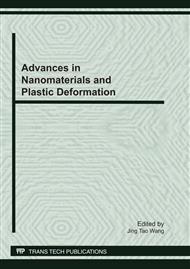p.75
p.81
p.89
p.97
p.103
p.109
p.115
p.123
p.131
Microstructure and Mechanical Properties of CP-Ti Processed by 2 ECAP Passes Using a 90° Die at Room Temperature
Abstract:
Equal channel angular pressing (ECAP) deformation for commercial pure titanium (CP-Ti) was successfully conducted using a conventional die with an angle of 90° between the channels at room temperature via route B, in which the billet was rotated 90° along its longitudinal axis between adjacent passes. Each billet was processed for two passes using a ram speed of 26mms-1. The microstructures and mechanical properties of these CP-Ti billets with an initial grain size of ~23μm processed by ECAP were investigated. Experiment results show thin parallel shear bands with a width of 0.3~0.4μm are generated after one ECAP pass, which are composed of large number of dislocation cell blocks. After the two ECAP passes, some various directional bands are generated and the equiaxed and smaller-than-average CBs in local areas begin to appear. In addition, the ultimate strength and microhardness are significantly enhanced to ~725MPa and ~2283MPa, respectively. Meanwhile good elongation of 18.0% to failure is still remained.
Info:
Periodical:
Pages:
103-108
Citation:
Online since:
March 2011
Authors:
Keywords:
Price:
Сopyright:
© 2011 Trans Tech Publications Ltd. All Rights Reserved
Share:
Citation:


